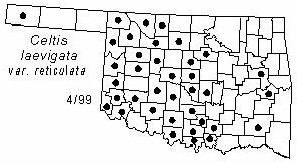
Small tree or large shrub to 10 m (30 ft) tall and 25 cm (10 in) in diameter. Bark gray, smooth to rough, with large corky warts. Twigs thin, brown, usually glabrous. Buds small, brown, finely hairy, no end bud. Leaves alternate, variable in size and shape but mostly triangular or ovate, 3-6 cm (1.2-2.4 in) long and 2-4 cm (0.8-1.6 in) wide, often strongly one-sided, thick, gray-green and rough above, yellow-green with network of raised veins below. Fruits on stalks at leaf bases, round, 6-10 mm (0.25-0.4 in) in diameter, dry and sweet, with one large seed.
Distribution: Native to most of the western half of the U. S.
Habitat: Dry uplands in the eastern part of its range, floodplains in more arid regions.
NWI status: UPL
Comment: This taxon is distinct in the western U. S. and is usually considered to be a species there. In central and west-central Oklahoma, where several species and varieties of Celtis occur together, numerous individual trees have characteristics of two or more of the taxa. Identification of a particular tree in this area is often difficult or impossible. The fruits are eaten by squirrels and many species of birds. Celtis is a name given by Pliny to some plant with sweet berries; laevigata means smooth, which is inappropriate for this variety; reticulata refers to the network of raised veins on the leaves.
Distribution in Oklahoma: 
BACK
NEXT
RETURN TO INDEX
Last update: 9/9/99
 Go to Oklahoma Biological Survey Home Page
Go to Oklahoma Biological Survey Home Page
 Disclaimer
Disclaimer